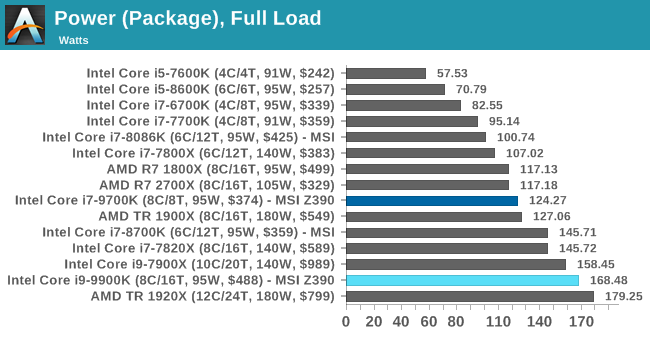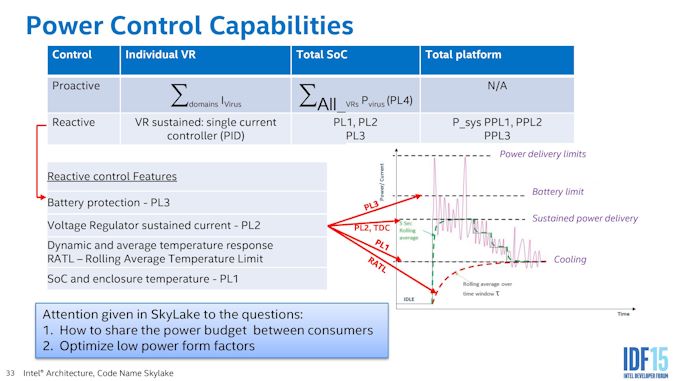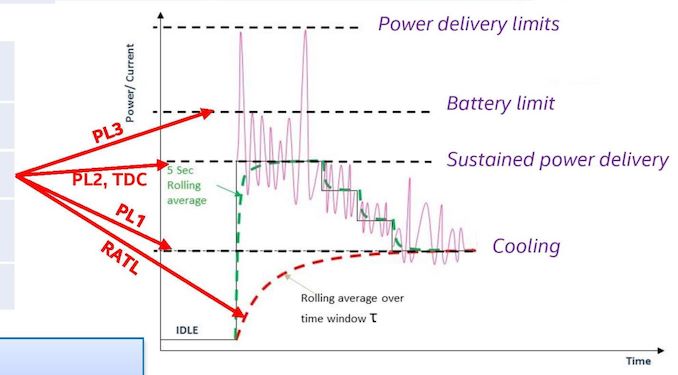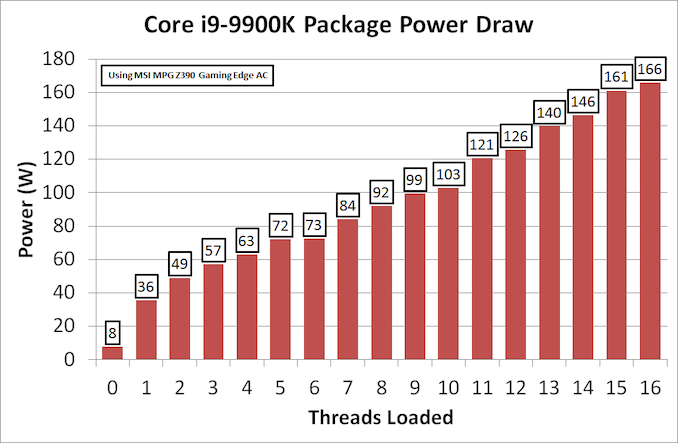The Intel 9th Gen Review: Core i9-9900K, Core i7-9700K and Core i5-9600K Tested
by Ian Cutress on October 19, 2018 9:00 AM EST- Posted in
- CPUs
- Intel
- Coffee Lake
- 14++
- Core 9th Gen
- Core-S
- i9-9900K
- i7-9700K
- i5-9600K
Power Consumption
TDP or not the TDP, That is The Question
Notice: When we initially posted this page, we ran numbers with an ASRock Z370 board. We have since discovered that the voltage applied by the board was super high, beyond normal expectations. We have since re-run the numbers using the MSI MPG Z390 Gaming Edge AC motherboard, which does not have this issue.
As shown above, Intel has given each of these processors a Thermal Design Power of 95 Watts. This magic value, as mainstream processors have grown in the last two years, has been at the center of a number of irate users.
By Intel’s own definitions, the TDP is an indicator of the cooling performance required for a processor to maintain its base frequency. In this case, if a user can only cool 95W, they can expect to realistically get only 3.6 GHz on a shiny new Core i9-9900K. That magic TDP value does not take into account any turbo values, even if the all-core turbo (such as 4.7 GHz in this case) is way above that 95W rating.
In order to make sense of this, Intel uses a series of variables called Power Levels: PL1, PL2, and PL3.
That slide is a bit dense, so we should focus on the graph on the right. This is a graph of power against time.
Here we have four horizontal lines from bottom to top: cooling limit (PL1), sustained power delivery (PL2), battery limit (PL3), and power delivery limit.
The bottom line, the cooling limit, is effectively the TDP value. Here the power (and frequency) is limited by the cooling at hand. It is the lowest sustainable frequency for the cooling, so for the most part TDP = PL1. This is our ‘95W’ value.
The PL2 value, or sustained power delivery, is what amounts to the turbo. This is the maximum sustainable power that the processor can take until we start to hit thermal issues. When a chip goes into a turbo mode, sometimes briefly, this is the part that is relied upon. The value of PL2 can be set by the system manufacturer, however Intel has its own recommended PL2 values.
In this case, for the new 9th Generation Core processors, Intel has set the PL2 value to 210W. This is essentially the power required to hit the peak turbo on all cores, such as 4.7 GHz on the eight-core Core i9-9900K. So users can completely forget the 95W TDP when it comes to cooling. If a user wants those peak frequencies, it’s time to invest in something capable and serious.
Luckily, we can confirm all this in our power testing.
For our testing, we use POV-Ray as our load generator then take the register values for CPU power. This software method, for most platforms, includes the power split between the cores, the DRAM, and the package power. Most users cite this method as not being fully accurate, however compared to system testing it provides a good number without losses, and it forms the basis of the power values used inside the processor for its various functions.
Starting with the easy one, maximum CPU power draw.

Focusing on the new Intel CPUs we have tested, both of them go beyond the TDP value, but do not hit PL2. At this level, the CPU is running all cores and threads at the all-core turbo frequency. Both 168.48W for the i9-9900K and 124.27W for the i7=9700K is far and above that ‘TDP’ rating noted above.
Should users be interested, in our testing at 4C/4T and 3.0 GHz, the Core i9-9900K only hit 23W power. Doubling the cores and adding another 50%+ to the frequency causes an almost 7x increase in power consumption. When Intel starts pushing those frequencies, it needs a lot of juice.
If we break out the 9900K into how much power is consumed as we load up the threads, the results look very linear.
This is as we load two threads onto one core at a time. The processor slowly adds power to the cores when threads are assigned.
Comparing to the other two ‘95W’ processors, we can see that the Core i9-9900K pushes more power as more cores are loaded. Despite Intel officially giving all three the same TDP at 95W, and the same PL2 at 210W, there are clear differences due to the fixed turbo tables embedded in each BIOS.
So is TDP Pointless? Yes, But There is a Solution
If you believe that TDP is the peak power draw of the processor under default scenarios, then yes, TDP is pointless, and technically it has been for generations. However under the miasma of a decade of quad core processors, most parts didn’t even reach the TDP rating even under full load – it wasn’t until we started getting higher core count parts, at the same or higher frequency, where it started becoming an issue.
But fear not, there is a solution. Or at least I want to offer one to both Intel and AMD, to see if they will take me up on the offer. The solution here is to offer two TDP ratings: a TDP and a TDP-Peak. In Intel lingo, this is PL1 and PL2, but basically the TDP-Peak takes into account the ‘all-core’ turbo. It doesn’t have to be covered under warranty (because as of right now, turbo is not), but it should be an indication for the nature of the cooling that a user needs to purchase if they want the best performance. Otherwise it’s a case of fumbling in the dark.














274 Comments
View All Comments
evernessince - Saturday, October 20, 2018 - link
I'm sure for him money is a fixed resource, he is just really bad at managing it. You'd have to be crazy to blow money on the 9900K when the 8700K is $200 cheaper and the 2700X is half the price.Dug - Monday, October 22, 2018 - link
Relative to how much you make or have. $200 isn't some life threatening amount that makes them crazy because they spent it on a product that they will enjoy. We spend more than that going out for a weekend (and usually don't have anything to show for it). If an extra 200 is threatening to your lively hood, you shouldn't be shopping for new cpu's anyway.close - Saturday, October 20, 2018 - link
@ekidhardt: "I think far too much emphasis has been placed on 'value'. I simply want the fastest, most powerful CPU that isn't priced absurdly high."That, my good man, is the very definition of value. It happens automatically when you decide to take price into consideration the price. I also don't care about value, I just want a CPU with a good performance to price ratio. See what I did there? :)
evernessince - Saturday, October 20, 2018 - link
A little bit extra? It's $200 more then the 8700K, that's not a little.mapesdhs - Sunday, October 21, 2018 - link
The key point being, for gaming, use the difference to buy a better GPU, whether one gets an 8700K or 2700X (or indeed any one of a plethora of options really, right back to an old 4930K). It's only at 1080p and high refresh rates where strong CPU performance stands out, something DX12 should help more with as time goes by (the obsession with high refresh rates is amusing given NVIDIA's focus shift back to sub-60Hz being touted once more as ok). For gaming at 1440p or higher, one can get a faster system by choosing a cheaper CPU and better GPU.
There are two exceptions: those for whom money is literally no object, and certain production workloads that still favour frequency/IPC and are not yet well optimised for more than 6 cores (Premiere is probably the best example). Someone mentioned pro tasks being irrelevant because ECC is not supported, but many solo pros can't afford XEON class hw (I mean the proper dual socket setups) even if the initial higher outlay would eventually pay for itself.
What we're going to see with the 9900K for gaming is a small minority of people taking Intel's mantra of "the best" and running with it. Technically, they're correct, but most normal people have budgets and other expenses to consider, including wives/gfs with their own cost tolerance limits. :D
If someone can genuinely afford it then who cares, in the end it's their money, but as a choice for gaming it really only makes sense via the same rationale if they've also then bought a 2080 Ti to go with it, though even there one could retort that two used 1080 TIs would be cheaper & faster (at least for those titles where SLI is functional).
If anything good has come from this and the RTX launch, it's the move away from the supposed social benefit of having "the best"; the street cred is gone, now it just makes one look like a fool who was easily parted from his money.
Spunjji - Monday, October 22, 2018 - link
Word.Total Meltdowner - Sunday, October 21, 2018 - link
This comment reads like shilling so hard. So hard. Please try harder to not be so obvious.Spunjji - Monday, October 22, 2018 - link
I think they placed just the right amount of emphasis on "value". Your post basically explains why it's not relevant for you in terms of you being an Intel fanboy with cash to burn. I'll elaborate.The MSRP is in the realm of irrational spending for a huge number of people. "Rational" here meaning "do I get out anything like what I put in", wherein the answer in all metrics is an obvious no.
Following that, there are a HUGE number of reasons not to pre-order a high-end CPU, especially before proper results are out. Pre-ordering *anything* computer related is a dubious prospect, doubly so when the company selling it paid good money to paint a deceptive picture of their product's performance.
Your assertion that Intel have never launched a bad CPU is false and either ignorance or wilful bias on your part. They have launched a whole bunch of terrible CPUs, from the P3 1.2Ghz that never worked, through the P4 Emergency Edition and the early "dual-core" P4 processors, all the way through to this i9 9900K which is the thirstiest "95W" CPU I've ever seen. Their notebook CPUs are now segregated in such a way that you have to read a review to find out how they will perform, because so much is left on the table in terms of achievable turbo boost limits.
Sorry, I know I replied just to disagree which may seem argumentative, but you posted a bunch of nonsense and half-turths passed off as common-sense and/or logic. It's just bias; none of it does any harm but you could at least be up-front that you prefer Intel. That in itself (I like Intel and am happy to spend top dollar) is a perfectly legitimate reason for everything you did. Just be open and don't actively mislead people who know less than you do.
chris.london - Friday, October 19, 2018 - link
Hey Ryan. Thanks for the review.Would it be possible to check power consumption in a test in which the 2700x and 9900k perform similarly (maybe in a game)? POV-Ray seems like a good way to test for maximum power draw but it makes the 9900k look extremely inefficient (especially compared to the 9600k). It would be lovely to have another reference point.
0ldman79 - Friday, October 19, 2018 - link
I'm legitimately surprised.The 9900k is starving for bandwidth, needs more cache or something. I never expected it to *not* win the CPU benchmarks vs the 9700k. I honestly expected the 9700k to be the odd one out, more expensive than the i5 and slower than the 9900k. This isn't the case. Apparently SMT isn't enabling 100% usage of the CPU's resources, it is allowing a bottleneck due to fighting over resources. I'd love to see the 9900K run against it's brethren with HT disabled.